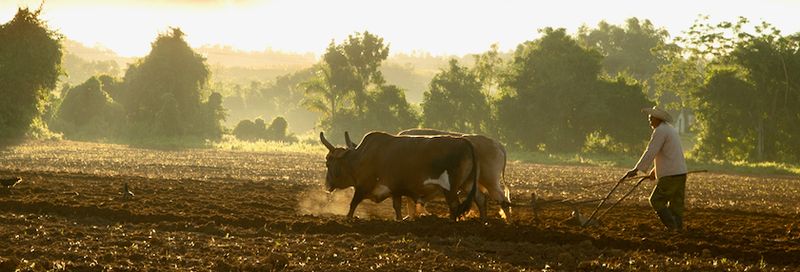Awesome Oxen


They built America, but where are they now?
For most of us, the charming nostalgia of The Oregon Trail computer game from the 1980s and 1990s is the closest we’ll ever come to thinking about oxen. They were integral with settling the American West, and were used for all the heavy chores.
So this raises a question…what exactly are oxen? Are they still in use today? Could you still put them to use today on your own acreage?

Let’s take a look as these questions and more:
- Oxen are cattle
So what is an ox? An ox is simply any domesticated bovine—male or female—that is used for draft work. Just as different horse breeds are better suited to different tasks, there are some cattle breeds that make better oxen. Dairy breeds or dual purpose breeds were often a good choice.
2. Oxen are ancient
The idea of harnessing the power of domesticated cattle to perform farm work occurred early in human history and has been happening for thousands of years. It’s really a fantastic idea: why not use the cattle’s amazing strength to plow a field, and in exchange, the cattle gets excellent fodder, shelter, and protection from predators? Numerous ancient Egyptian paintings and carvings show a farmer and a yoke of oxen accomplishing daily farming tasks.

3. Oxen can perform many tasks
Oxen can do all kinds of draft animal work. Often working in pairs, yoked side-by-side, oxen can be hooked to a plow to prepare the soil for planting crops. They are also used for pulling carts and loads, even hauling stone-filled sleds out of newly reclaimed fields. And they’re sometimes used as logging oxen, pulling felled trees out of the forest. They have a lot of stamina and a “slow and steady wins the race” attitude to work.
4. Oxen are often steers
There’s no rule that says you can’t train a bull to perform draft work, but bulls can naturally be a bit difficult to work with. It’s also possible to use a cow for an ox, and this has certainly been done over the years as well. The most popular option (and the one that some people will think of when they hear the word ox) is a steer. Steers are castrated bulls that tend to grow larger and stronger than bulls, and their docile demeanors often make them ideal working animals.
5. Oxen require careful training
Oxen are often trained to be controlled heavily with verbal commands, with the oxen “teamster” also guiding the team physically as they walk alongside. Common words for turning left and right are “haw” and “gee,” with “get up” and “whoa” used for starting and stopping.
6. Oxen defined the ‘acre’
Today, an acre is a precise 43,560 square feet. But in ages past, the measurement got its start as roughly the amount of land a single farmer and a team of oxen could plow during one summer’s day.
7. Oxen built the West
The classic computer game got it right—teams of oxen really did pull covered wagons across the the U.S. to populate regions of Oregon, California, and more. In addition to their gentle nature, oxen were able to subsist on a more varied and less nutritious diet than horses or mules.

8. But oxen aren’t just for pioneers
Oxen are just as capable of performing farm work as they were thousands of years ago. Sure, a single team of oxen isn’t going to accomplish the same amount of work as a massive tractor, but that was never the goal anyway. Even today, oxen are used for farming worldwide, though not commonly in the U.S.
However, there are a few reasons you might consider trying some small-scale farming with oxen:
- Oxen don’t require fossil fuels! You can literally power an oxen using “fuel” you grow yourself.
- Oxen are good for the land! They can be a fabulous source of compost to improve garden or crop soil.
- Low cost! Compared to tractors and other farm machinery, oxen are pretty inexpensive, although the training investment (for both oxen and teamster) is not insignificant.
- Oxen are maneuverable. They can manuever in places that might be impossible for a tractor or UTV—especially helpful for logging, where the oxen can enter tree-filled areas inaccessible by machine.
There is something wonderful about working each day with livestock, something no machine can replace. Have you ever thought about farming with oxen? Is it something you would ever consider trying?
Tags:Country Critters

Acreage Life is part of the Catalyst Communications Network publication family.
















